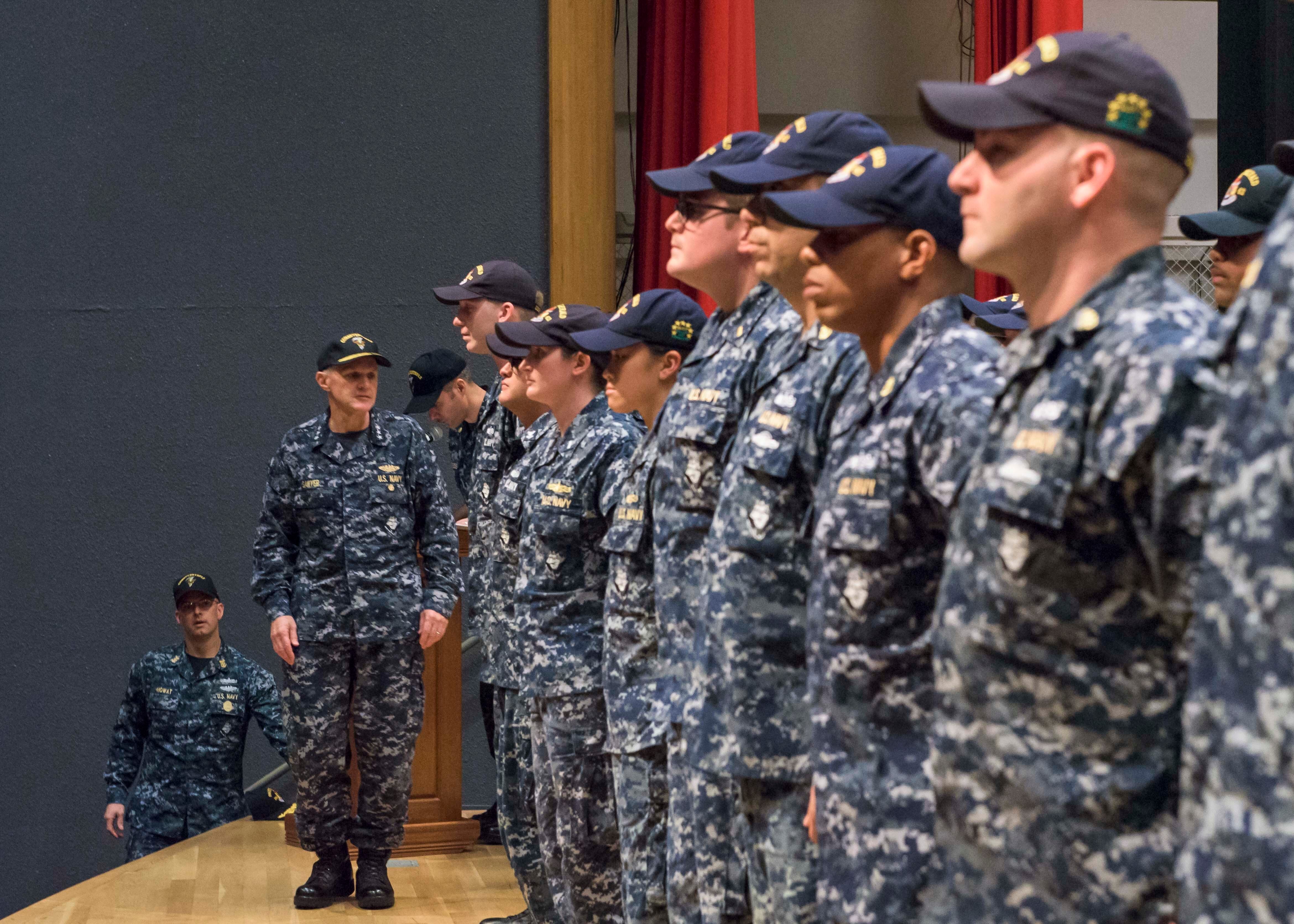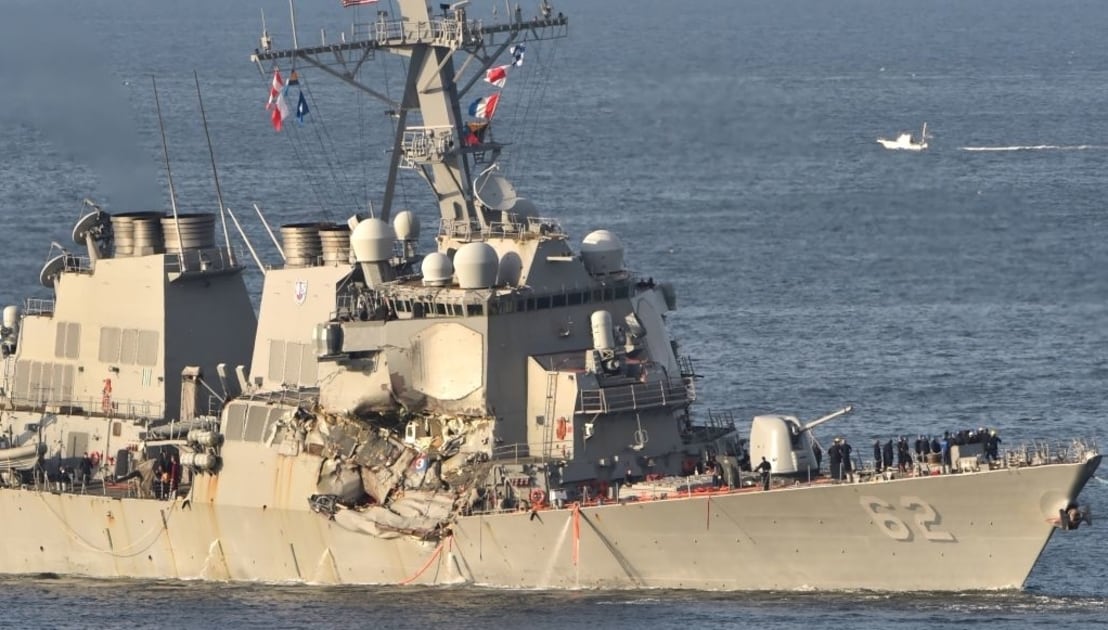WASHINGTON — In the lead-up to the summer of 2017, when 17 sailors died in two collisions with commercial tankers, communication channels had broken down.
The staff of the U.S. Navy’s 7th Fleet, based in Yokosuka, Japan, was bending over backward to keep ships that were behind on maintenance and training underway, despite repeatedly sending warnings up the chain of command that all was not well, according to the fired 7th Fleet commander, retired Vice Adm. Joseph Aucoin.
RELATED

By the time news broke that a second destroyer in as many months had collided with a commercial ship, killing 10 sailors aboard, it was clear 7th Fleet had hit a breaking point. Aucoin’s staff had routinely recommended against tasking, the admiral recounted in an opinion piece in the U.S. Naval Institute’s Proceedings magazine, but were routinely rebuffed.
But that regime has changed, according to Vice Adm. Phil Sawyer, who spoke to Defense News in March from aboard his command ship Blue Ridge while on patrol in the East China Sea.
Click here for more stories, videos and interviews from Sea-Air-Space!
Sawyer, who was elevated to 7th Fleet faster than expected due to Aucoin’s relief, is tasked with implementing a new rotational presence model in the western Pacific — based on a readiness cycle for his 11 Yokosuka-based cruisers and destroyers — that closely resembles the one applied to ships based in the United States.
Prior to the accidents, ships in Japan were routinely operating under waivers for lapsed certifications in warfare areas such as damage control, navigation and flight deck operations. In this new model, ships don’t go on missions until they are trained and certified to perform them.
“It’s incumbent upon me that before I put my ships out on operations, that they are fully trained and certified to do that mission,” Sawyer said. “And my entire team knows that.
“So if a ship was being tasked to do something and it wasn’t fully trained and certified, it just wouldn’t even get that far. Because at every level of my staff, including the [combined task forces] out here, they know that there’s not even going to be a conversation about assigning someone who isn’t trained and certified. It’s a red line.”
In the unlikely scenario where such an order came from his office, U.S. Pacific Fleet would backstop it, Sawyer continued.
“Let’s just say we’re in the implausible situation where action came up to me and I said: ‘I recognize that we are not trained and certified, but we are going to go do it.’ [U.S. Pacific Fleet Commander Adm. John] Aquilino gets to see a similar data set to what I see, and he and I talk once a week. He’s the only guy who can put an operational waiver in for a ship to go do something that it’s not trained and certified to go do," Sawyer added.
“So, one: I’m very confident it would never come up from my staff. Two: It wouldn’t get past me. And three: If it did, the final guy would be Adm. Aquilino, and it’s very clear it’s a red line for him, too.”
RELATED

‘Different than what it was’
The changes to 7th Fleet weren’t introduced solely because Sawyer and Aquilino took lead jobs immediately following the accidents and accountability actions, Sawyer noted. Rather, the changes are etched in instructions.
“This isn’t just our policy, there are instructions out there that govern this,” Sawyer said. “I’m very confident and comfortable that the team out here understands it. And it’s not just because the teams out here get it — it’s codified in instructions. It’s just different than what it was in years past.”
In years past, the situation was very different. In his op-ed, Aucoin described a situation where he routinely pushed back on requests for forces from U.S. Pacific Fleet and U.S. Pacific Command, and he was routinely ordered to deploy his ships.
“It was often the case that operational missions (more often than not of the ‘short-notice’ variety) came down from [U.S. Pacific Command and U.S. Pacific Fleet] with warning orders or that ‘requests for forces’ were met with a ‘not recommended’ response from C7F,” Aucoin wrote, using an acronym for the 7th Fleet commander. “More often than not, we would be directed to fill and execute the mission through a follow-on task order or voice order directing the by-name identified ship to execute the mission.
“In a few cases, we were able to argue for changes that allowed ships to complete training or maintenance. In many other cases, our arguments and recommendations were either overruled or ignored.”
The accidents led to a full-scale decapitation of the command structure in 7th Fleet, with Aucoin, his task force and the strike group commanders being relieved of command, and Pacific Fleet Commander Adm. Scott Swift being very publicly passed over for promotion to head Pacific Command in favor of Adm. Phil Davidson, who led the review of the accidents.
But the conditions that existed prior to the accidents are in the past now, Sawyer said.
“We’re watching much more closely the training and certification,” he reiterated. “And if they are not really trained and certified to do the mission we ask them to do, we’re just not going to send them.”
David B. Larter was the naval warfare reporter for Defense News.







